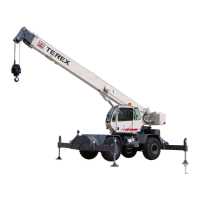The operator must exercise sound judgment in positioning the outriggers.
The outriggers should not be set near holes, on rocky ground or on
extremely soft ground. Setting the outriggers in such locations may result
in the crane tipping, causing personal injury or property damage. Where a
firm footing or level ground is not otherwise available, it should be
provided by substantial timbers, solid blocking, or other structural
members sufficient to distribute the load so as not to exceed the safe
bearing capacity of the underlying material, and to enable leveling of the
crane.
Proper positioning of the outriggers is critically important to both the safety and
effectiveness of craning operations.
Before making any crane lift, make sure the hook is properly engaged with the
slings, or lifting device employed to make the lift. Be certain the hook latch is
not supporting any of the load. Refer to the warning tag on the hook block.
3. Use the load rating chart attached to the crane to interpret the conditions and
limitations that exist when making a lift with the crane. The determining factors
are lifted load, radius, boom angle, working position, hoist line reeving, tire
pressure, travel data, and use of a jib.
The examples given in this section are given for your interpretation of the
terminology used on the chart. CAUTION: The load rating chart values used in
the examples may not be the same as those on your road rating chart. Use the
numbers from the chart attached to your crane whenever making lift calculation
Always consider, anticipate, and/or determine by trial the maximum
amount of wire rope which will be payed off the winch drum to perform
each different craning application of this crane. Be sure to provide for no
less than three full wraps of wire rope remaining on the winch drum as
specified in all applicable crane operating safety standards.
The increased possibility for inadequate wraps remaining on the winch drum
occurs when operating with a higher number of parts of line than are required
for the load being lifted, particularly at longer boom lengths and high boom
angles. Sufficient wire rope is initially provided to allow the hook block to reach
ground level when reeved for the required parts of line indicated on the
93P/N 12261-319 REVISED: August 2012
Courtesy of Crane.Market

